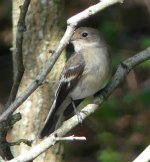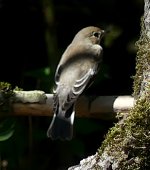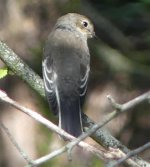Hi everybody,
I know that 1st winter black and white flycatchers are best forgotten if you want to sleep peacefully but this one shows rather unusual traits. Any comment or opinion welcomed.
The bird was seen in France, in Paris, september 2nd 2020.
Aged 1st winter by pattern of tertials for instance.
Unusual traits (compared with hypoleuca) :
- broad primary patch (estimated 3 mm at its broadest point)
- obvious bar on median coverts wich may have two generations of feathers (white tipped and grey-cream tipped), not unlike bar on greater coverts.
- inner part (not only web) of R3 with pale grey zone (visible on some pictures only)
- overall much greyer than the typical Pied Flycatchers present at the same place
- last but not least, five obvious white (more obvious in the field than on pictures) round spots on the rump (remnant of juv plumage ? or ?)
It didn't feed in the open but inside the bushes, close to the ground and even
sometimes on the ground (other ficedula were feeding more "normally"). But I don't know if it's of any use identification-wise.
Thanks !
I know that 1st winter black and white flycatchers are best forgotten if you want to sleep peacefully but this one shows rather unusual traits. Any comment or opinion welcomed.
The bird was seen in France, in Paris, september 2nd 2020.
Aged 1st winter by pattern of tertials for instance.
Unusual traits (compared with hypoleuca) :
- broad primary patch (estimated 3 mm at its broadest point)
- obvious bar on median coverts wich may have two generations of feathers (white tipped and grey-cream tipped), not unlike bar on greater coverts.
- inner part (not only web) of R3 with pale grey zone (visible on some pictures only)
- overall much greyer than the typical Pied Flycatchers present at the same place
- last but not least, five obvious white (more obvious in the field than on pictures) round spots on the rump (remnant of juv plumage ? or ?)
It didn't feed in the open but inside the bushes, close to the ground and even
sometimes on the ground (other ficedula were feeding more "normally"). But I don't know if it's of any use identification-wise.
Thanks !







